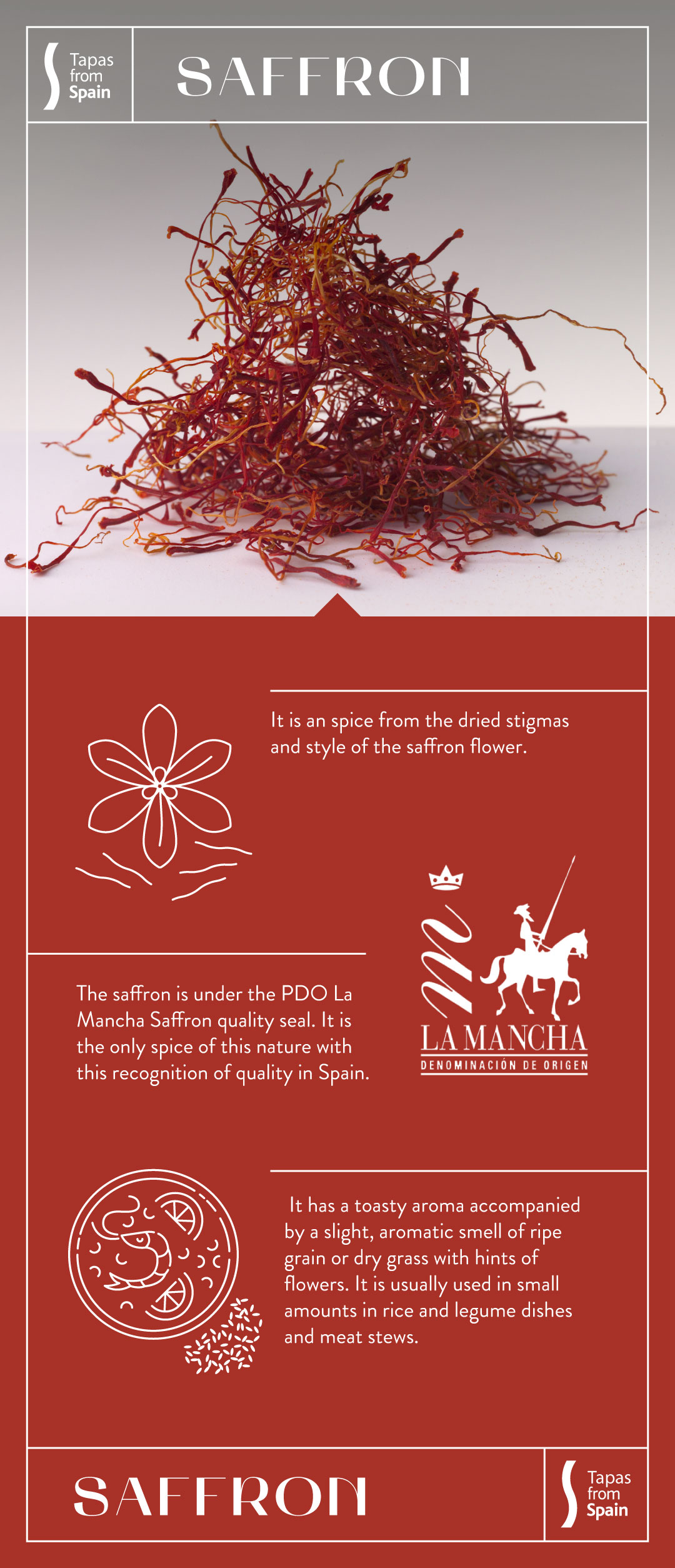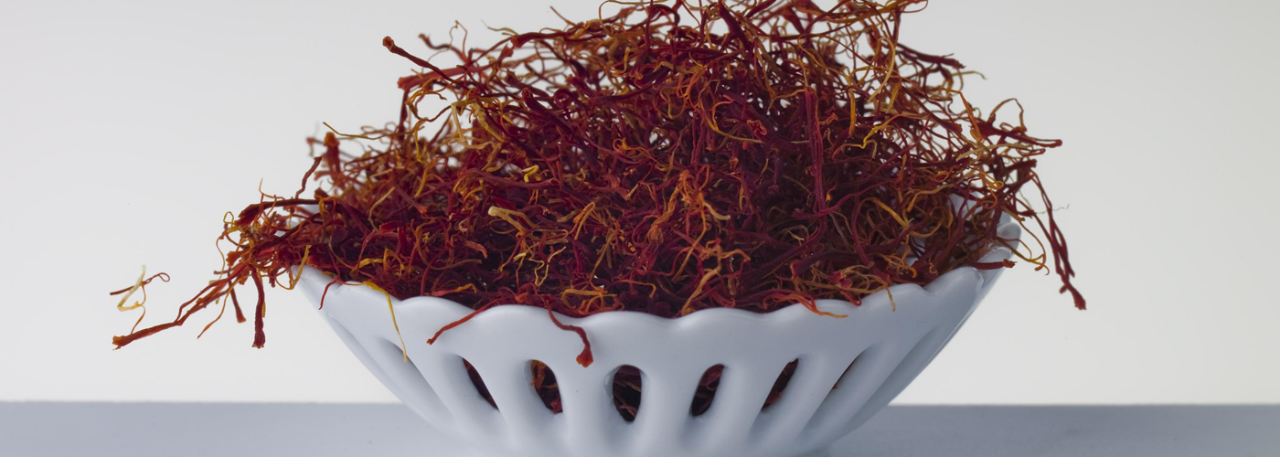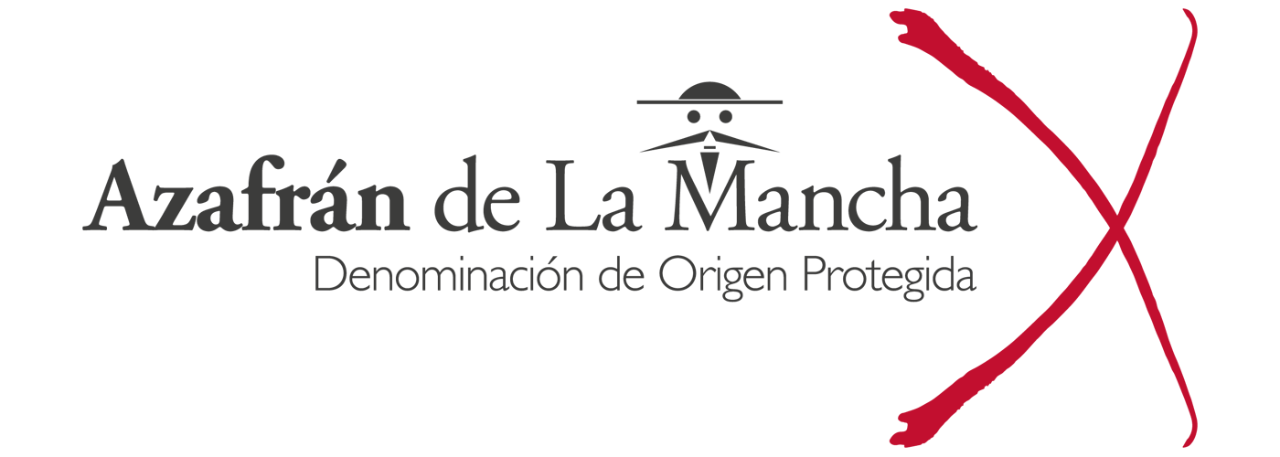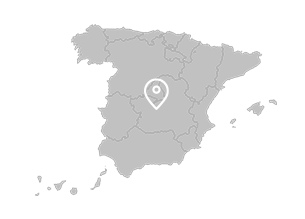.png.transform/rendition-xs/image_image%20(1).png)
Azafrán de La Mancha PDO
Spice from the dried stigmas and style of the saffron flower, Crocus sativus L., from the designated production area.
Tasting notes
The toasty aroma is intense and penetrating, and is accompanied by a slight, aromatic smell of ripe grain or dry grass with hints of flowers. When infused, the olfactory-gustatory sensation is long and smooth, although slightly bitter at the start, then turning to persistent ripe grain and toast. It is characterized by a lack of astringent flavor.
Other notes
The following are the physical-chemical parameters:
- Moisture and volatile matter: below 11% m/m (7-9 % for bulk saffron)
- Total ash: 8% m/m
- Insoluble ash in acid: below 1% m/m
- Ethereal extract: 3.5-14.5 % m/m
- Soluble extract in cold water: below 65% m/m
- Coloring strength: over 200 for both packed and bulk saffron (expressed as a direct measure of absorbency at 440 nm over dry weight)
- Aromatic strength: over 20, for both packed and bulk saffron (expressed as a direct measure of absorbency at 330 nm, over dry weight)
- Bitterness strength (picrocrocin): over 70, for both packed and bulk saffron (expressed as a direct measure of absorbency at 257 nm, over dry weight)
- Safranal content: over 65% for both packed and bulk saffron (expressed in percentage of total volatile components)
Production / Processing method
The saffron crocus, Crocus sativus L., belongs to the family Iridaceae. Its spherical corm, two to three centimeters in diameter, is fleshy and coated with brownish-grey reticular membranes. From October to November, one to three tube-shaped buds grow from each corm together with long, thin leaves. Flowers colored from lilac to deep purple then develop, opening up to reveal their interior. This comprises the ovary from which three yellow stamens and a white filament grow. The latter is the style which divides into three red stigmas, the saffron threads.
The La Mancha saffron flower differs in appearance from those grown in other production areas because the red stigmas project further from the flower and the style is longer. The ratio between the lengths of the stigma and the style must be over one, with a tolerance of 1%. The length of the stigma may be no less than 22 mm, also with a tolerance of 1%. The floral waste content may be no more than 0.5% in weight. This refers to styles detached from their stigmas, stamens, pollen, and parts of the flower petals and ovary.
The tolerance of foreign matter is a maximum of 0.1%, this being considered to be any plant remains apart from those from the saffron flower, that is, minerals (sand, soil and/or dust) and dead insects or insect parts, etc. There must be neither mold nor live insects.
Saffron is grown on the same soil for a three-year cycle. It is then removed to another plot that has not been used for cultivating saffron, beetroot or alfalfa for five years previously. The corms are traditionally planted as from the second half of June until the first half of September.
Once the flowers start to blossom, they must be picked while open and before they wilt. The picking period lasts for approximately 30 days, usually from October to November, depending on weather conditions during the growing period.
Picking the flowers requires great skill and precision, to prevent the stigmas from coming loose. The harvested flowers are taken carefully, ensuring they are neither crushed nor overheated, to the place where separation of the stigmas is carried out. There they are laid out in thin layers on sacks or canvases or on firm ground.
Separation of the stigmas must take place within 12 hours after picking. They are cut out together with the style at the part where the latter is beginning to turn white. They are then arranged in layers up to 1.5 cm thick in fine-meshed metal or silkcloth sieves for toasting.
The saffron is toasted for 20 to 45 minutes over hot coals or over any other appropriate source of indirect heat which provides constant, uniform heat but not unwanted flavors or smells. The toasted saffron is then weighed and packed in clean, new, food-grade containers to protect it from moisture and light, and is stored until dispatch in clean, cool, dry storerooms.
Packing may be done either manually or automatically and the containers may hold a maximum of 100 g. The closing system must guarantee preservation of the product, and the containers must be stored in clean, dry, well-ventilated facilities at a temperature of no more than 25 ° C.
The La Mancha saffron has a high coloring strength. It can be identified by the numbered back-label issued by the Regulatory Council. This saffron must be sold during the year of harvesting as its quality decreases over time, and it must be sold only in thread form, never ground into a powder. The threads are flexible and strong, and the stigmas are bright red.
Geography / Relief and climate
The growing area lies from the center of Castile-La Mancha down to the south-east. As a crop, saffron is very well-suited to the climate of this area. The average altitude is about 700 m above sea level, and the soils are generally limey, with a clayey-sandy texture.
The climate is continental Mediterranean, mostly warm with plenty of sunshine, hot, dry summers and cold winters, with marked temperature changes (maxima from 38Cº to 42ºC / 100º F to 107º F and minima from 6ºC to -12ºC). Rainfall is scarce, which is the main factor limiting crop size.
Regulatory Council
Consejo Regulador de la D.O.P. Azafrán de La Mancha
Pº de Castilla-La Mancha, 15 - Bajo A
45720 Camuñas (Toledo)
Tel: (+34) 925 470 284
doam@doazafrandelamancha.com
www.doazafrandelamancha.com
Sources:
- Spanish Ministry of Agriculture

The La Mancha saffron flower differs in appearance from others because the red stigmas project further from the flower and the style is longer.


- Azafrán de La Mancha 1
- Azafrán de La Mancha 2

Camuñas (Castile-La Mancha)
